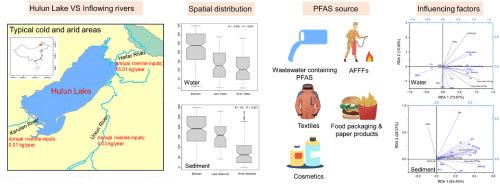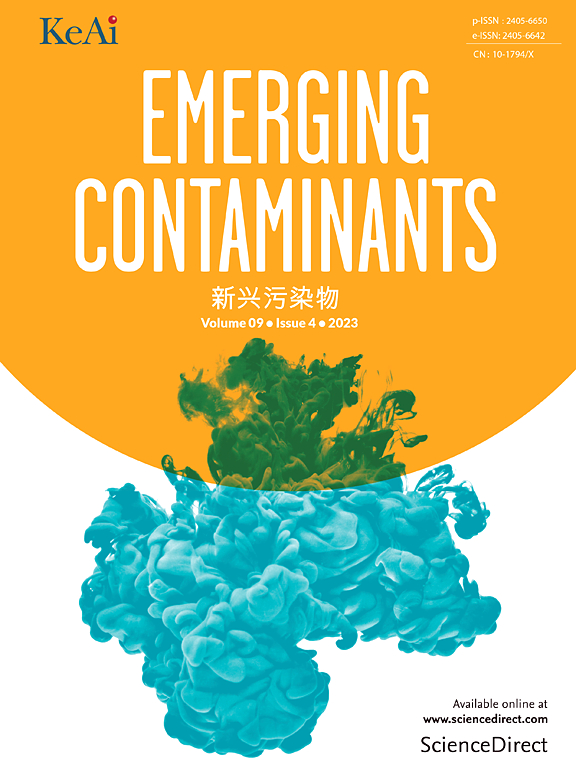The first survey of legacy and emerging per- and polyfluoroalkyl substances (PFAS) in Hulun Lake, China: Occurrence, sources, and environmental impacts
IF 5.3
2区 环境科学与生态学
Q1 ENVIRONMENTAL SCIENCES
引用次数: 0
Abstract
Many per- and poly-fluoroalkyl substances (PFAS) studies in environmental media have been conducted in heavily industrialized and densely populated areas. However, there has been limited research on legacy and emerging PFAS contamination in cold and arid regions. In the present study, we investigated the concentrations of 30 PFAS compounds in the surface water and sediment of Hulun Lake and its inflowing rivers. The main components in water were short chain perfluoroalkyl carboxylic acids (PFCAs) in both Hulun Lake (33.57 %) and its inflowing rivers (30.47 %). However, long chain perfluoroalkane sulfonates (PFSAs) and long chain PFCAs accounted for more than half of the total PFAS content in sediment. Total PFAS concentrations (∑30PFAS) ranged from 3.67 to 8.84 ng/L in water, and 0.97–1.73 μg/kg in sediment. Significant spatial differences were apparent between Hulun Lake and its inflowing rivers in both water and sediment samples. Source apportionment revealed that wastewater, aqueous film forming foams, textiles and paper-based food packaging, and paper products and cosmetics were the primary sources of PFAS. The partitioning coefficients of PFCAs were dependent on the carbon chain length. Temperature, conductivity, pH, salinity, chemical oxygen demand, total phosphorus (TP), total nitrogen (TN), As, and oxidation-reduction potential were the main influencing factors in water. Heavy metals (Co, Pb, Cu, Ni, Hg, Cd, and As), TP, salinity, and pH were positively correlated with the PFAS concentration in sediment. Furthermore, Hailar River contributed the majority (99.74 %, ∼15.05 kg/year) of the PFAS mass flux. This is the first study showing PFAS contamination in Hulun Lake and the results suggest that long term monitoring is needed for the effective control of PFAS pollution in this typical cold and arid region of China.

首次调查中国呼伦湖中遗留的和新出现的全氟烷基和多氟烷基物质 (PFAS):发生、来源和环境影响
环境介质中的许多全氟和多氟烷基物质 (PFAS) 研究都是在工业化程度高、人口稠密的地区进行的。然而,对寒冷和干旱地区遗留的和新出现的 PFAS 污染的研究还很有限。本研究调查了呼伦湖及其流入河流的地表水和沉积物中 30 种 PFAS 化合物的浓度。在呼伦湖(33.57%)及其流入河流(30.47%)中,水中的主要成分是短链全氟烷基羧酸(PFCAs)。然而,沉积物中长链全氟烷基磺酸盐(PFSAs)和长链全氟烷基羧酸(PFCAs)占全氟烷基磺酸盐总含量的一半以上。水中的全氟辛烷磺酸总浓度(∑30PFAS)介于 3.67 至 8.84 纳克/升之间,沉积物中的全氟辛烷磺酸总浓度介于 0.97 至 1.73 微克/千克之间。呼伦湖及其入湖河流的水样和沉积物样品均存在明显的空间差异。来源分配显示,废水、水成膜泡沫、纺织品和纸质食品包装以及纸制品和化妆品是 PFAS 的主要来源。全氟辛烷磺酸的分配系数取决于碳链长度。温度、电导率、pH 值、盐度、化学需氧量、总磷 (TP)、总氮 (TN)、砷和氧化还原电位是水中的主要影响因素。重金属(钴、铅、铜、镍、汞、镉和砷)、总磷、盐度和 pH 值与沉积物中的 PFAS 浓度呈正相关。此外,海拉尔河贡献了大部分(99.74%,∼15.05 千克/年)的 PFAS 质量通量。这是首次对呼伦湖的全氟辛烷磺酸污染进行研究,研究结果表明,要有效控制中国这一典型寒冷干旱地区的全氟辛烷磺酸污染,需要进行长期监测。
本文章由计算机程序翻译,如有差异,请以英文原文为准。
求助全文
约1分钟内获得全文
求助全文
来源期刊

Emerging Contaminants
Medicine-Public Health, Environmental and Occupational Health
CiteScore
10.00
自引率
6.70%
发文量
35
审稿时长
44 days
期刊介绍:
Emerging Contaminants is an outlet for world-leading research addressing problems associated with environmental contamination caused by emerging contaminants and their solutions. Emerging contaminants are defined as chemicals that are not currently (or have been only recently) regulated and about which there exist concerns regarding their impact on human or ecological health. Examples of emerging contaminants include disinfection by-products, pharmaceutical and personal care products, persistent organic chemicals, and mercury etc. as well as their degradation products. We encourage papers addressing science that facilitates greater understanding of the nature, extent, and impacts of the presence of emerging contaminants in the environment; technology that exploits original principles to reduce and control their environmental presence; as well as the development, implementation and efficacy of national and international policies to protect human health and the environment from emerging contaminants.
 求助内容:
求助内容: 应助结果提醒方式:
应助结果提醒方式:


